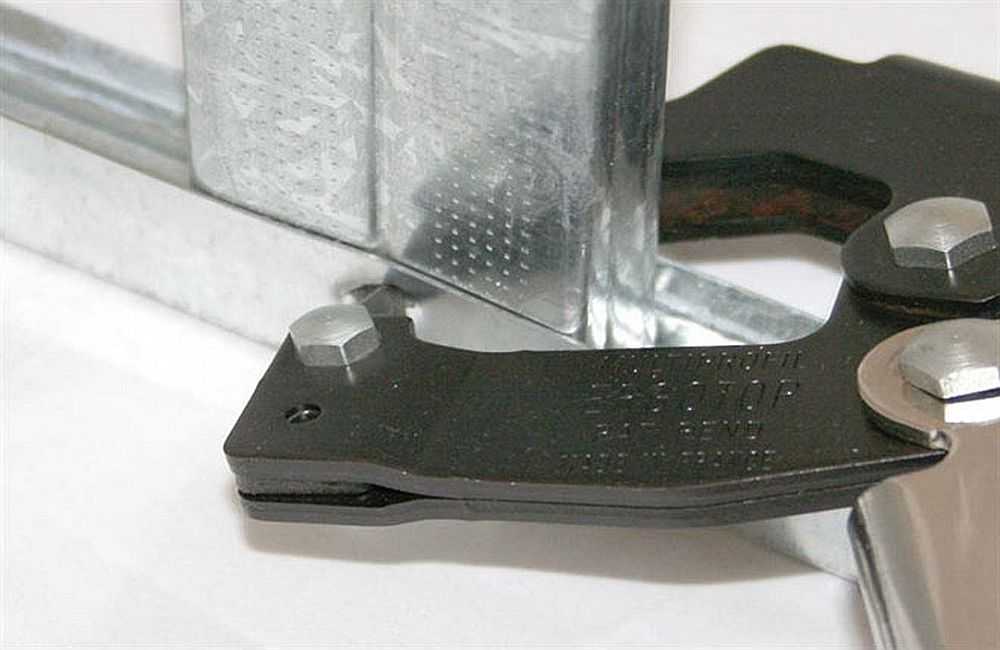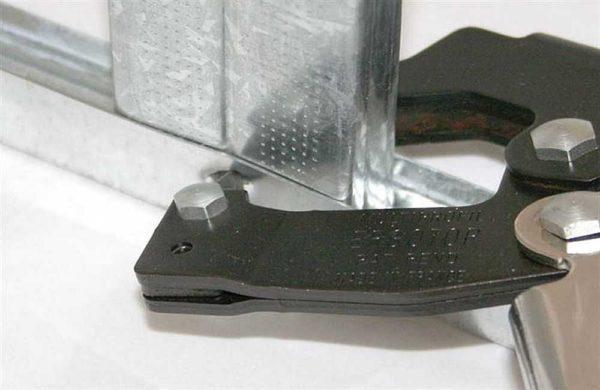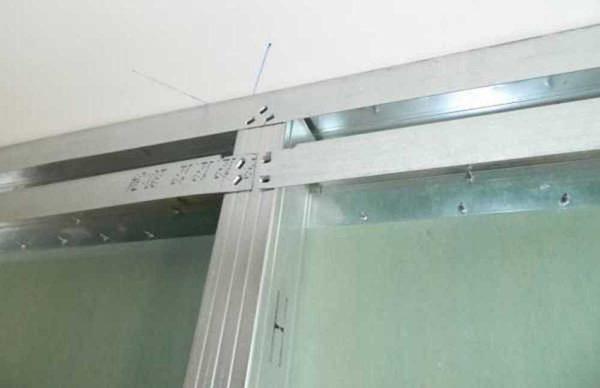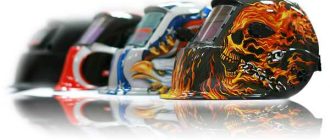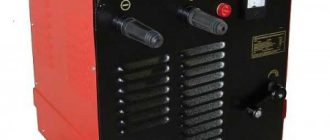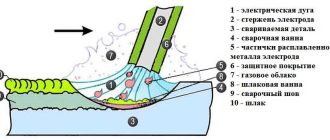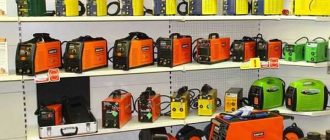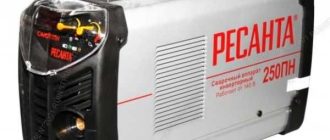Partitions, ceilings, false walls are often constructed of plasterboard. And it is mounted on a framework of metal profiles. A significant part of time is spent on assembling this very frame. To reduce the time without loss of quality allows the sifter for metal profiles. It is a hand tool that connects two profiles in seconds.
文章内容
What is a sheet metal slicer?
A slicer or slicing pliers is a handheld tool for joining sheet metal products. The connection is made by forming a through hole in the parts to be joined. The parts to be joined are fixed by bending the formed metal petals. That is, to connect sheet metal products with the help of a slicer, no fasteners or additional actions are required.
Put in the right place the working part of the tool, press the handles. The metal is penetrated, its pieces are bent. That’s it. Because of the fact that the metal is “pierced”, went another name for this tool – a profile puncher. The same tool can be found under the name “pliers for connecting GC-profiles”. This is how some manufacturers position it. There are also other names – sizer, profile punch. This is already from the jargon of builders and home masters.
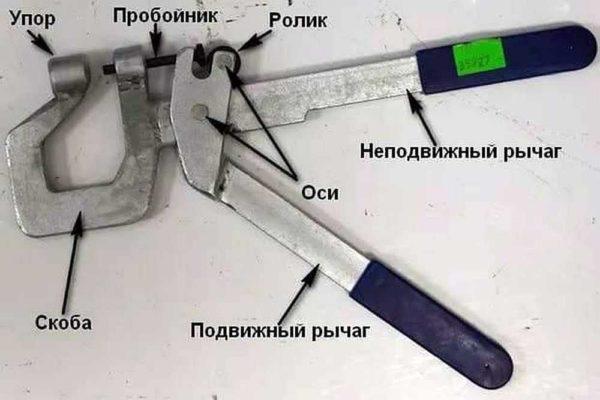
Externally, the slicer is the same pliers, but with long handles and an unfamiliar structure of the working part. Like ordinary pliers, they have two jaws, but they are different in shape. On one side is a stop, on the other a punch. The punch is the protruding part that makes a hole in the metal. The stop is the thickened part with a hole where the punch goes in.
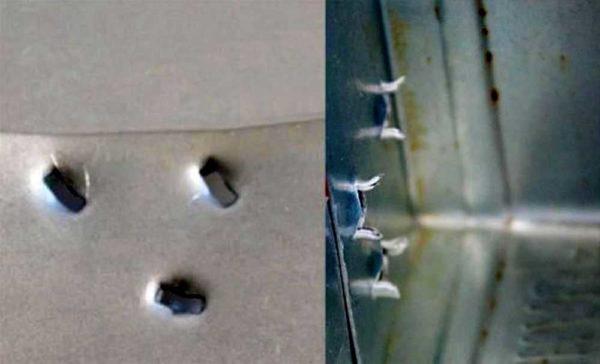
The shape of the working part is designed so that the metal petals that are formed when making a hole are slightly bent. This ensures that the products are securely fixed to each other. The shape of the hole is usually rectangular, but can be square or round. Rectangular is preferable, because it gives a more “rigid” connection.
Pros and cons of using sizers
This type of tool is not too popular yet. It is difficult to name the reasons, because the thing is really good. Especially for those who are engaged in the installation of drywall systems, and for home masters, too, a necessary thing. What are the pros:
- Quick and reliable connection of profiles. The speed of installation of the frame under the drywall increases significantly. The principle of operation is simple: put the connected parts between the jaws, squeeze the handles, move, repeat. And so as many times as required.
- There is no need to use fasteners. This is a saving of time and money.
- The tool is manual, so electricity is not needed. You can work on any objects.
- There is no protrusion at the connection point of the profiles. When mounting on rivets or self-tapping screws, the head protrudes above the surface of the profile. Self-tapping screws have more, rivets have less. This prevents the sheet of drywall to lie flat, without bends. When using a slicer, the bends remain on the “back” side of the profile. The front side turns out to be without protrusions. The sheet lies flat, which reduces the time for putty and its consumption.
Few of those who have tried to work with a sizer return to self-tapping screws. Although, it must be said, there are some of them. Sometimes in difficult places, the connection is “tacked” with a self-tapping screw, then use a sizer, and the screw is unscrewed. But these are those who like to be overinsured. With some skill of work, additional fixation is not required.
缺点
Now about the disadvantages. The use of a sifter for drywall profiles does reduce the time spent. But the tool is manual and requires the application of muscular force. With large volumes of installation, namely of structures made of profiles, fatigue quickly accumulates. And by the end of the working day, the speed of work falls. The better the tool, the less effort is needed, but they are still needed. And this is a disadvantage.
The second disadvantage is the complexity of disassembly. To disconnect two profiles, you need to bend the metal petals. Time is required more than when unscrewing self-tapping screws. But less than when removing rivets. It seems that these are all the difficulties and disadvantages of working with a slicer.
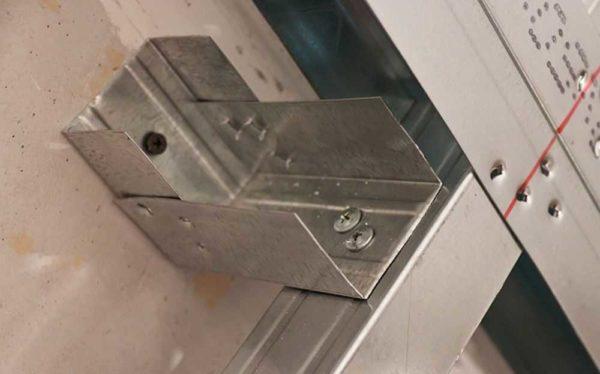
There is another disadvantage, which is due to the shape of the working part. Some nodes – lintels, locks – it is simply impossible to “get” the slicer. The puncher does not fit there in any way. There are models with very large “windows”, but they are not very good for ordinary connections. For professionals to have several different models is normal, but for home use – a clear overkill.
Self-tapping screws or sizer
About the fact that when using sifters, the sheet lies down more evenly, already said. And this is a clear plus in favor of the sieve connection. The second unconditional plus – time saving. The third is the absence of consumables.
In the disadvantages of connecting the profiles of the GC slicer recorded insufficient strength of fastening. Self-tapping screws are more reliable. Perhaps, but the strength of the frame is needed only until the moment of covering it with GKL. And it is enough with the head, even if each connection to do only one fastener. But decide what is better – sizer or self-tapping – you.
Types and designs
The assortment of sizers in our stores is not so great, but in large construction stores you can see about a dozen different models. What are they like? First, there are models for sheet metal (pictured below). They have a very small gap in the working part, which is also called “window”. In sifters for sheet metal, this window is only about a centimeter wide. Any metal will fit there, but the profile for drywall only guide (PN) or rack (PS) with small shelves. And that can be a problem.
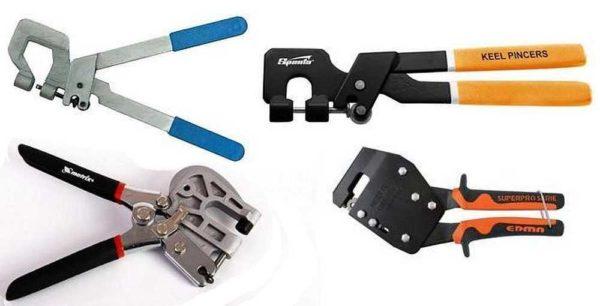
If we talk about models for connecting drywall, then they have a larger “window”. It is made in the form of a square, rectangle or with rounded corners. The larger the window, the easier it will be with the connection of rack profiles with any width of shelves. But then the size of the “head” increases, which is not always convenient. Professionals simply have several different tools, and for repair and household use choose something average.

There are also different shapes of holes: rectangular, round, square. There are different sizes. The greater the thickness of the metal, the larger the size of the puncher (or bit) is required. There are models with replaceable punches, and there are rotary. In rotary or revolving (pictured above), the nozzle is changed by turning a wheel with differently shaped and sized bits. If you plan to work with sheet metal often – this is a good thing. For occasional use such luxury is not necessary.
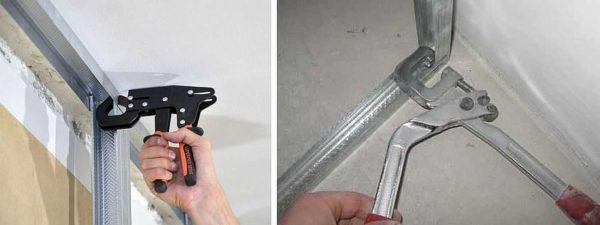
There is also a metal profile slicer for convenient fastening of profiles under the ceiling or at the floor. Their handles are not a continuation of the working part, but are set at an angle. Some (Ultra Profil EDMA) are at 90°, others at 45°. This tool speeds up the work even more when creating frameworks for suspended ceilings.
One-handed and two-handed and the principle of operation
It is also worth remembering that there are one-handed and two-handed models. In one-handed ones, there is a return spring, which unclamps the handles after releasing the tension.
The one-handed ones are not easy to work with. Especially on good profiles made of normal metal. So often the one-handed ones are often operated with two hands anyway. In such a case, the order of work with a slicer for KG profiles is as follows:
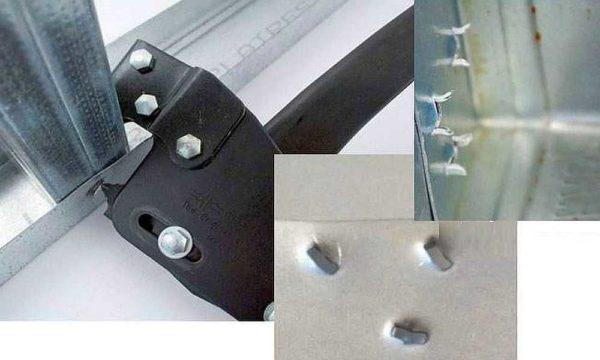
- Set the profiles on the level.
- With the left hand fix them in the desired position.
- Tool in the right. Drive its working part to the desired point, squeeze until the bit does not bump into the metal.
- The left hand is removed (profiles “holds” the slicer), squeeze the handles with both hands.
Two-handed work differs in the fact that the handles are at such a distance that you can’t even pick them up with one hand. Well, and they are also designed to connect thicker metal.
How to choose a sizer for a metal profile
Perhaps the difficult thing is the choice of a specific model of the slicer. They are divided, as usual, into household and professional. The difference in price is more than appreciable. The cheapest and acceptable in quality can be purchased for about 10$, normal – from 20-30$, and really good can cost 100$ and more.
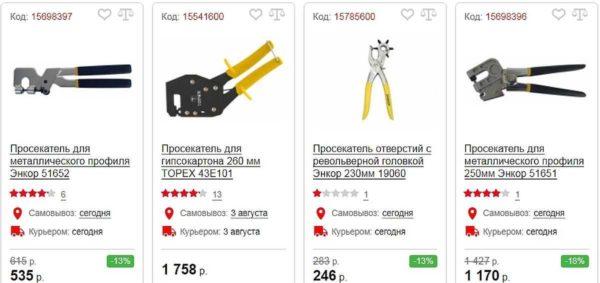
What is the difference? In the working resource and ease of use. And this means that in the more expensive ones apply more durable and expensive metals, rubber and plastic for handles, etc. They have a more complex device of the working part, there is a mechanism that reduces the force required for connection. In general, there is something to pay for. But nevertheless, for occasional work, for home, you can find quite good and workable copies in the cheap segment.
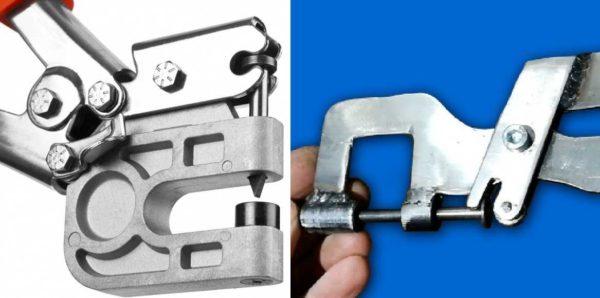
When choosing a profile slicer from any category, look at the following parameters:
- The maximum thickness of the parts to be fastened. Pay attention, the total thickness of metal that can be penetrated by this tool is indicated. That is, if 1.2 mm is specified, it means that you can take two sheets of 0.6 mm or 0.8 mm + 0.4 mm, but in no way two sheets of 1.2 mm.
- Shape and size of the “window”. Rounded corners make it easier to work.
- The presence of a roller that pushes the puncher. Such models are more expensive, but it is necessary to apply much less effort.
- The body is without defects, caverns, cracks, massive and heavy.
- Evaluate ergonomics.
- Handles should be comfortable, with stops.
- It is ideal if the handles have rubberized tabs. Otherwise, you will have to work in gloves – there will be blisters.
- The handles in the extended state can be grasped with one hand.
- Smooth operation when squeezing.
- No backlash.
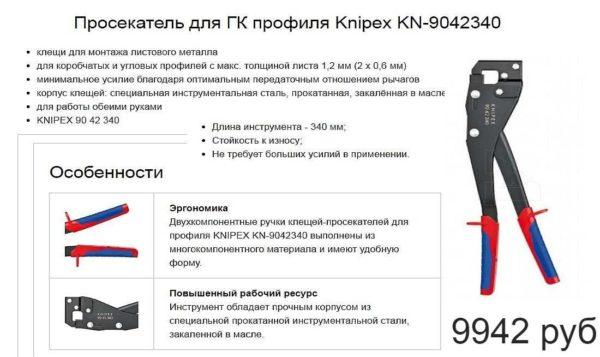
And it is very desirable that the company was known. Although, there are also nameless “Chinese”, which are very good for home use.

